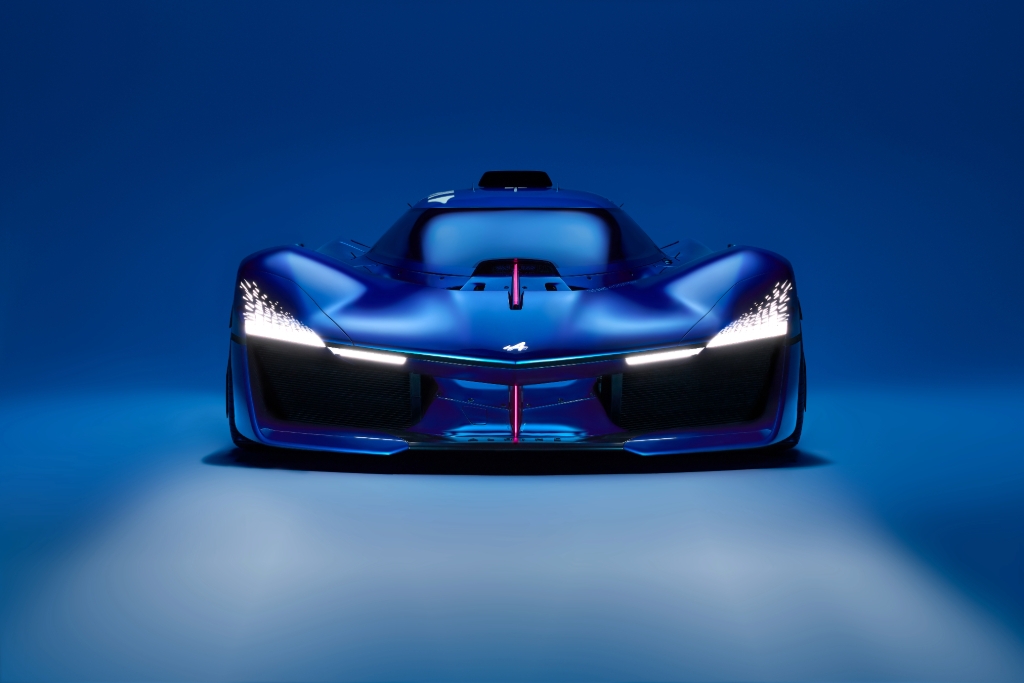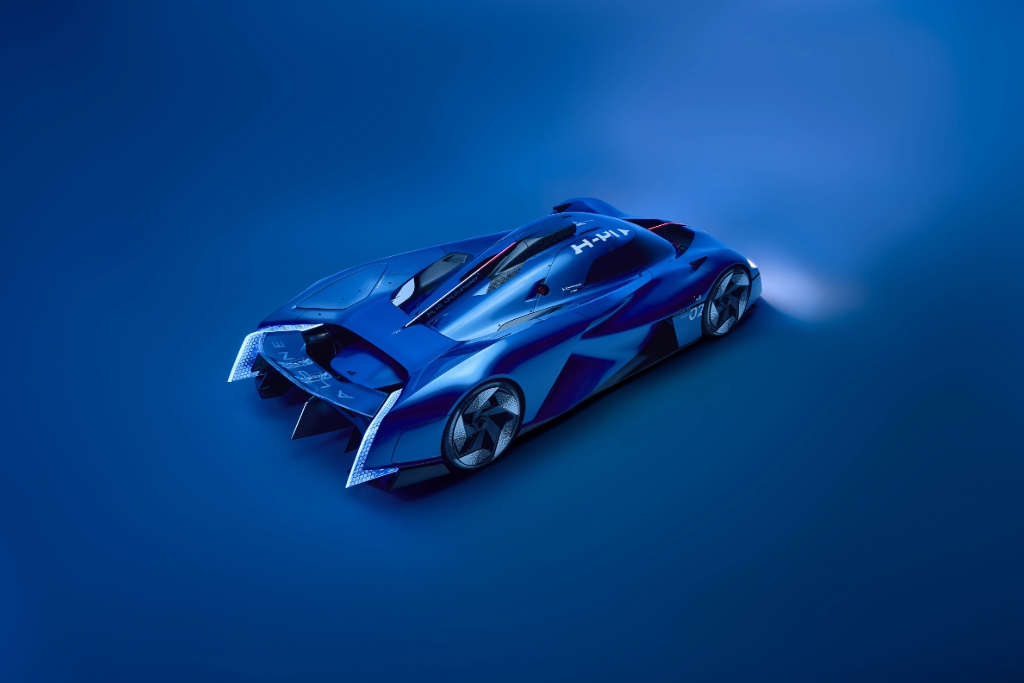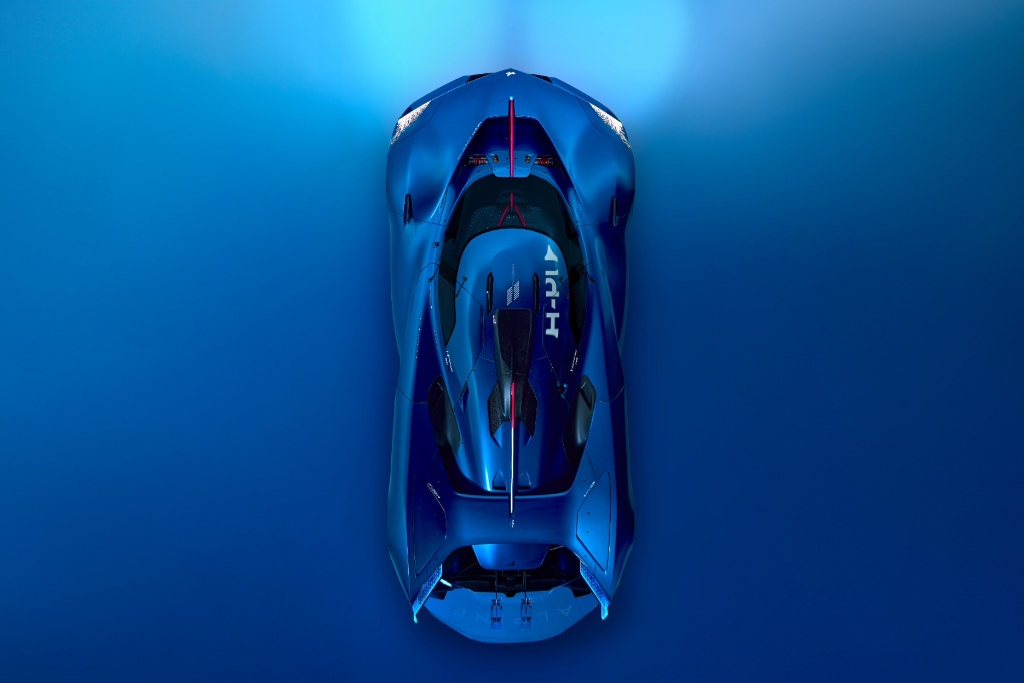Alpine shows off the Alpine Alpenglow Hy4
13 May 2024|302 views
At the 2022 Paris Motor Show, Alpine presented its Alpenglow concept, displaying the brand's future direction in design and sustainable innovation. Back then, the model had already embodied the brand's ongoing research into hydrogen-powered combustion engines for sports cars. On the one hand, this held the potential of high performance both on the road and in competition. On the other hand, however, the car was also a demonstration of Alpine's efforts in working towards its decarbonisation targets.
Now, however, the Alpenglow is no longer just a static concept car. Meet the Alpine Alpenglow Hy4: A functioning rolling-lab designed racing car, with a carbon monocoque frame, and a turbocharged 2.0-litre four-cylinder engine which puts out 340bhp (which we'll get to in just a bit). The car was first unveiled to the public on 11 May 2024 - before over 70,000 spectators - before the TotalEnergies 6 Hours of Spa-Francorchamps Endurance Race (FIA WEC).
Although bearing a close visual resemblance to the Alpenglow concept, the Alpine Alpenglow Hy4 rolling lab has better proportions, a redesigned crash box, greater height and an enlarged interior to accommodate two seats. All of this comes on top of its retention of the two hydrogen tanks - which are still located at the side pods and behind the cockpit.
Externally, the car's front end has been designed to evoke the sensation of a comet arriving from outer space, as seen through the 'cosmic dust' light particles in the four front lights and the magenta-coloured dorsal contour. Towards the rear of the prototype, the latter turns blue, just like the vertical lights located next to the vertical titanium exhaust pipes.
The front splitter has also been redesigned to create a low air intake. New NACA air intakes are also integrated to serve the oil and water radiators. On top of that, the snorkel takes on a shape closer to that of a racing car. The long-tail rear end is reminiscent of the Alpine A220 racing car from the late 1960s, while the rear diffuser has been redesigned for greater aerodynamic efficiency.
Elsewhere, the wheel rims are fitted with tyres produced by Michelin, whose graphics matches the design of the rims. The Alpine Alpenglow Hy4 also uses a low, transparent spoiler, just like what was seen on the concept car.
The elytra-shaped doors have been designed to free up as much space as possible while facilitating access to the cockpit. The driver and passenger are able to slide over the side pods which slope towards the cockpit, reaching the bucket seats.
A typical Alpine feature, the triangle at the front of the cockpit, provides a variety of functions such as indicating the level of the lateral Gs in real time, engine speed, or to give information on travelling speeds.
The dash panel features a magenta tubular crossbar, fitted with Alcantara trim, embellished with 3D-printed motifs. The starter button is also magenta coloured. Buttons from the Alpine A110 can also be seen on the Alpine Alpenglow Hy4, similar to the racing steering wheel.
Designed like a racing car, the Alpine Alpenglow has a LMP3 carbon chassis. But to come back to what lies under the hood, here's where the the catch lies: The Hy4 features a 2.0-litre turbocharged development engine... powered by gaseous hydrogen. As mentioned earlier, three tanks store hydrogen in gas form under high pressure. A pressure regulator reduces the pressure from 700 to 200 bars before eventually hitting a 40 bars low which is then injected into the combustion chamber. Water injection, on the other hand, helps to reduce NOx emissions.
What this means is that the Alpenglow Hy4 sets itself apart from many other hydrogen-powered cars in recent memory, which rely on a fuel-cell stack to convert hydrogen into electricity. Its hydrogen-engine will deliver quite a generous level of output too - 340bhp, to be specific - and can reach a maximum of 7,000rpm. Impressively, Alpine claims that the car can also reach a top speed of 270km/h - comparable to a petrol equivalent.
Having made its public at Spa-Francorchamps, Alpine has further plans to show the Alpenglow Hy4 off in other parts of the world too. Demonstration runs of this vehicle are set to happen during the 92nd edition of the 24 Hours of Le Mans on 14 and 15 June 2024.
At the 2022 Paris Motor Show, Alpine presented its Alpenglow concept, displaying the brand's future direction in design and sustainable innovation. Back then, the model had already embodied the brand's ongoing research into hydrogen-powered combustion engines for sports cars. On the one hand, this held the potential of high performance both on the road and in competition. On the other hand, however, the car was also a demonstration of Alpine's efforts in working towards its decarbonisation targets.
Now, however, the Alpenglow is no longer just a static concept car. Meet the Alpine Alpenglow Hy4: A functioning rolling-lab designed racing car, with a carbon monocoque frame, and a turbocharged 2.0-litre four-cylinder engine which puts out 340bhp (which we'll get to in just a bit). The car was first unveiled to the public on 11 May 2024 - before over 70,000 spectators - before the TotalEnergies 6 Hours of Spa-Francorchamps Endurance Race (FIA WEC).
Although bearing a close visual resemblance to the Alpenglow concept, the Alpine Alpenglow Hy4 rolling lab has better proportions, a redesigned crash box, greater height and an enlarged interior to accommodate two seats. All of this comes on top of its retention of the two hydrogen tanks - which are still located at the side pods and behind the cockpit.
Externally, the car's front end has been designed to evoke the sensation of a comet arriving from outer space, as seen through the 'cosmic dust' light particles in the four front lights and the magenta-coloured dorsal contour. Towards the rear of the prototype, the latter turns blue, just like the vertical lights located next to the vertical titanium exhaust pipes.
The front splitter has also been redesigned to create a low air intake. New NACA air intakes are also integrated to serve the oil and water radiators. On top of that, the snorkel takes on a shape closer to that of a racing car. The long-tail rear end is reminiscent of the Alpine A220 racing car from the late 1960s, while the rear diffuser has been redesigned for greater aerodynamic efficiency.
Elsewhere, the wheel rims are fitted with tyres produced by Michelin, whose graphics matches the design of the rims. The Alpine Alpenglow Hy4 also uses a low, transparent spoiler, just like what was seen on the concept car.
The elytra-shaped doors have been designed to free up as much space as possible while facilitating access to the cockpit. The driver and passenger are able to slide over the side pods which slope towards the cockpit, reaching the bucket seats.
A typical Alpine feature, the triangle at the front of the cockpit, provides a variety of functions such as indicating the level of the lateral Gs in real time, engine speed, or to give information on travelling speeds.
The dash panel features a magenta tubular crossbar, fitted with Alcantara trim, embellished with 3D-printed motifs. The starter button is also magenta coloured. Buttons from the Alpine A110 can also be seen on the Alpine Alpenglow Hy4, similar to the racing steering wheel.
Designed like a racing car, the Alpine Alpenglow has a LMP3 carbon chassis. But to come back to what lies under the hood, here's where the the catch lies: The Hy4 features a 2.0-litre turbocharged development engine... powered by gaseous hydrogen. As mentioned earlier, three tanks store hydrogen in gas form under high pressure. A pressure regulator reduces the pressure from 700 to 200 bars before eventually hitting a 40 bars low which is then injected into the combustion chamber. Water injection, on the other hand, helps to reduce NOx emissions.
What this means is that the Alpenglow Hy4 sets itself apart from many other hydrogen-powered cars in recent memory, which rely on a fuel-cell stack to convert hydrogen into electricity. Its hydrogen-engine will deliver quite a generous level of output too - 340bhp, to be specific - and can reach a maximum of 7,000rpm. Impressively, Alpine claims that the car can also reach a top speed of 270km/h - comparable to a petrol equivalent.
Having made its public at Spa-Francorchamps, Alpine has further plans to show the Alpenglow Hy4 off in other parts of the world too. Demonstration runs of this vehicle are set to happen during the 92nd edition of the 24 Hours of Le Mans on 14 and 15 June 2024.
Latest COE Prices
July 2025 | 2nd BIDDING
NEXT TENDER: 06 Aug 2025
CAT A$101,102
CAT B$119,101
CAT C$68,600
CAT E$120,000
View Full Results Thank You For Your Subscription.




























